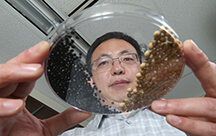Researchers identify gene that controls soybean seed permeability, calcium content
June 22, 2015
 |
|
Agronomist Jianxin Ma holds a dish of seeds from cultivated soybeans (right) and from their wild, hard-coated progenitors (left). (Purdue Agricultural Communication / Tom Campbell) |
WEST LAFAYETTE, Ind. - Purdue University researchers have pinpointed the gene that controls whether soybean seed coats are hard or permeable, a finding that could be used to develop better varieties for southern and tropical regions, enrich the crop's genetic diversity and boost the nutritional value of soybeans.
Jianxin Ma (Jen-SHIN' Ma), associate professor of agronomy, and fellow researchers found that a mutation in the gene GmHs1-1 causes the tough seed coats of wild soybeans to become permeable. Farmers selected that trait about 5,000 years ago in a key step to domesticating soybeans from their hard-seeded relative Glycine soja.
The gene could be modified to produce improved varieties for growing regions in which seed permeability can be a handicap, Ma said. GmHs1-1 is also associated with the calcium content of soybeans, offering a genetic target for enhancing the nutrition of soy food products.
Understanding the mechanism that determines seed permeability could also give researchers better access to the largely untapped genetic diversity of wild soybeans to enrich cultivated varieties, whose lack of genetic richness has curbed improvements in yields.
"This is the first gene associated with hard seededness to be identified in any plant species," Ma said. "This discovery could help us quickly pinpoint genes that control this trait in many other plants. We're also excited about the potential applications for modifying the calcium concentration in seed coats. This could be transformative as we identify similar genes that control calcium levels in other legumes."
Hard seededness enables the long-term survival of many wild plant species by protecting seeds in severe conditions and inhospitable environments, allowing them to remain dormant until conditions are right for germination. Encased in a water- and airtight coat, seeds can remain viable for extended periods of time, in some cases, more than 100 years.
But the hard skin that lends wild seeds their resilience is a problem in agricultural production. It prevents seeds from germinating quickly and in a uniform, predictable pattern. Wild soybean seeds take from several weeks to months to germinate whereas cultivated soybean seeds can begin absorbing water in 15 minutes.
Millennia ago, farmers in Asia recognized the value of seed permeability and artificially selected the trait to produce the predecessors of modern cultivated soybean varieties, Ma said.
But the genetic factors underpinning seed coat permeability remained a mystery until Ma and his team used a map-based cloning approach to hone in on GmHs1-1 as the gene responsible for hard seededness.
The team found that a mutation in a single pair of nucleotides in the gene causes seed coat permeability - that is, a change in one pair out of the approximately 1 billion base pairs that make up the soybean genome.
"We finally understand the genetic change that allowed the domestication of soybeans," he said. "When we make this kind of discovery, we're always very excited."
Ma said modifying the gene could produce hardier seeds for the southern U.S. and the tropics, regions in which the soft coats of cultivated soybeans reduce their viability shortly after harvest.
The discovery could also help researchers improve the cooking quality of soybeans and other legumes, such as the common bean, whose varying levels of hard seededness make consistent quality difficult to achieve.
The team's next goal is to identify genes that interact with GmHs1-1 and understand how they work together to control calcium and possibly other mineral content.
The paper was published in Nature Genetics on Monday (June 22) and is available at http://dx.doi.org/10.1038/ng.3339.
Collaborators on the research team included Randall Nelson of the U.S. Department of Agriculture and the University of Illinois, Chunmei Cai of Qingdao Agricultural University and Zhanyuan Zhang of the University of Missouri.
Principle funding for the research was provided by the Indiana Soybean Alliance. Additional funding came from the North Central Soybean Research Program, Ag Alumni Seed, Qingdao Agricultural University and the Purdue Agricultural Research Program.
Writer: Natalie van Hoose, 765-496-2050, nvanhoos@purdue.edu
Source: Jianxin Ma, 765-496-3662, maj@purdue.edu
ABSTRACT
The calcineuri-like gene GmHs1-1 controls hard seededness in soybeans
Lianjun Sun 1; Zhenyan Miao 1; Chunmei Cai 2; Dajian Zhang 1; Meixia Zhao 1; Yanyan Wu 2; Xueling Zhang 2; Stephen A. Swarm 3; Liwen Zhou 4; Zhanyuan J. Zhang 4; Randall L. Nelson 3; Jianxin Ma 1
1 Department of Agronomy, Purdue University, West Lafayette, IN 47906, USA
2 College of Life Sciences, Qingdao Agricultural University, Qingdao 266109, China
3 Department of Crop Sciences, University of Illinois, Urbana, IL 61801, USA
4 Plant Transformation Core Facility, Division of Plant Sciences, University of Missouri, Columbia, MO 65211, USA
5 Soybean/Maize Germplasm, Pathology, and Genetics Research Unit, U.S. Department of Agriculture-Agricultural Research Service, Urbana, IL 61801, USA
E-mail: maj@purdue.edu
Loss of seed-coat impermeability was an essential step toward domestication of many leguminous crops for production of their highly nutritious seeds. Here we show that seed-coat impermeability in wild soybean is controlled by a single gene, designated GmHs1-1, which encodes a calcineurin-like metallo-phosphoesterase transmembrane protein. GmHs1-1 is primarily expressed in the malphighian layer of the seed coat and associated with calcium content. The transition from impermeability to permeability was caused by artificial selection of a point mutation within GmHs1-1. Interestingly, a number of soybean landraces escaped from the selection for permeability, due to an alternative selection for seed-coat cracking that also enables seed imbibition. Despite the single origin of the mutant allele (Gmhs1-1), the distribution pattern of allelic variants in the context of soybean population structure and the detected signature of genomic introgression between the wild and cultivated soybeans suggest that Gmhs1-1 may have experienced reselection for seed-coat permeability.
Ag Communications: (765) 494-2722;
Keith Robinson, robins89@purdue.edu
Agriculture News Page

